
Globular cluster Terzan 5
Many enjoy searching for the brilliant Perseids or the majestic Milky Way, but the universe holds more subtle treasures, jewels that, although difficult to see, tell fascinating stories about the origin of our own galaxy. One such treasure is the globular cluster Terzan 5.
What is Terzan 5?
Discovered by Turkish-French astronomer Agop Terzan in the 1960s, Terzan 5 is not a typical globular cluster.
Globular clusters are enormous spheres composed of hundreds of thousands of stars, as old as the cosmos, orbiting the nucleus of a galaxy.
However, Terzan 5 is different. It is tucked away in the central bulge of the Milky Way, a dense area filled with dust that blocks most of its light, making it extremely difficult to detect, even from the clearest skies in the world.
What makes Terzan 5 special is not its brilliance, but its structure. Unlike most globular clusters, which contain stars of a single age, Terzan 5 contains at least two groups of stars with very different ages and chemical compositions.
Some of its stars are extremely old, more than 12 billion years old (almost the age of the universe), while others are “young,” about 4.5 billion years old.

Terzan 5 | Credit: NASA/ESA/Hubble/F. Ferraro
Terzan 5, a Cosmic Fossil
This age difference has led astronomers to a surprising conclusion:
Terzan 5 could be a “cosmic fossil,” or the remnant of one of the primordial components that came together to form the central bulge of the Milky Way in its early days.
Rather than being a simple globular cluster, Terzan 5 is thought to be the surviving nucleus of a dwarf galaxy or a fragment of dark matter that our Milky Way absorbed billions of years ago.
It functions like a stellar time capsule, preserving the traces of key events in the formation of our galaxy. Analyzing it allows us to peer into the distant past and better understand how the Milky Way evolved from a collection of minor structures to the imposing spiral we see today.
These are the physical characteristics of Terzan 5:
Distance: It is located about 25,000 light-years away from Earth, in the constellation of Sagittarius, right in the direction of the galactic center, about 5,000 light-years from its center.
Size: Despite the number of stars it contains, it is relatively compact, with a radius of almost 3 light-years. This means that its stars are very close together, much closer than what we are used to seeing in other globular clusters.
Mass: It is estimated to be 2 million times the mass of our Sun.
Stellar population: Although the number is very difficult to determine due to the opacity of stardust, it hosts hundreds of thousands of stars, including neutron stars and pulsars.
Why is Terzan 5 so special?
Aside from hosting two populations of stars and being a good candidate for information on the origins and formation of our Milky Way, pulsars, neutron stars, and X-ray sources await within.
Terzan 5 is known for being a veritable “nest” of pulsars, with more than 30 detected to date, making it one of the densest globular clusters of these objects in the Milky Way.
Among them are some of the fastest pulsars in the galaxy, known as millisecond pulsars, which spin at astonishing speeds of hundreds of times per second.
Pulsars are neutron stars, the ultra-dense remnants of massive stars that have collapsed after a supernova. They rotate rapidly and emit beams of electromagnetic radiation, acting as cosmic beacons that we can detect.
Among them, PSR J1748−2446ad stands out.
Discovered in 2004 by Jason W. T. Hessels, it is the fastest pulsar known to date, spinning at an astonishing speed of 716 times per second (716 Hz), or 42,960 revolutions per minute.

Location of PSR J1748-2446ad. Credit: Zellfaze, CC0, via Wikimedia Commons
Furthermore, Terzan 5 is a notable source of X-ray emissions, much of which come from exotic binary systems.
In these systems, a neutron star captures material from a nearby companion star. This stolen material forms an accretion disk around the compact object, where the gas is heated to extreme temperatures of millions of degrees, emitting intense X-rays.
Its high stellar density favors the formation of these binary systems, as gravitational interactions between stars can generate close pairs that evolve into these configurations.
Recent telescope studies have revealed that it hosts dozens of X-ray sources, making it a natural laboratory for investigating the physics of compact objects and the extreme conditions of the galactic bulge.
Therefore, although observing Terzan 5 directly is a nearly impossible challenge due to the dust that obscures it in the galactic bulge, its existence and what it teaches us are a fascinating testament to the enigmas that the cosmos still holds.
As we gaze at starry nights, the thought that a cosmic relic from our galaxy’s infancy is so close, yet so well hidden, acting as a natural laboratory for pulsars and X-ray sources, awakens a deep awe for the night sky.
So, the next time you look up at the Milky Way, remember that in the dense heart of our galaxy lies a silent witness to the Milky Way’s chaotic origins.
Astronomy invites us not only to observe, but to unravel the extraordinary stories that stars and their cosmic relics whisper to us through time.

 Español
Español
